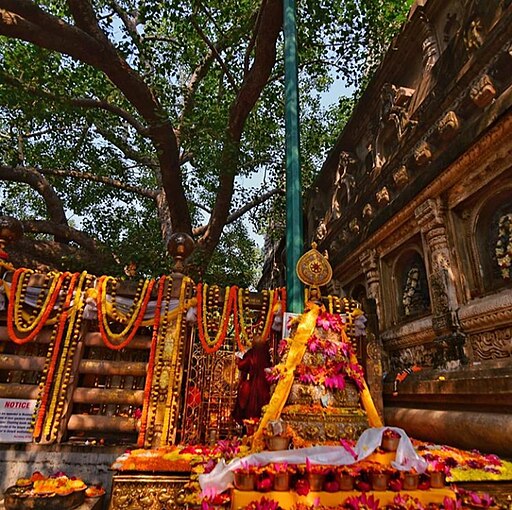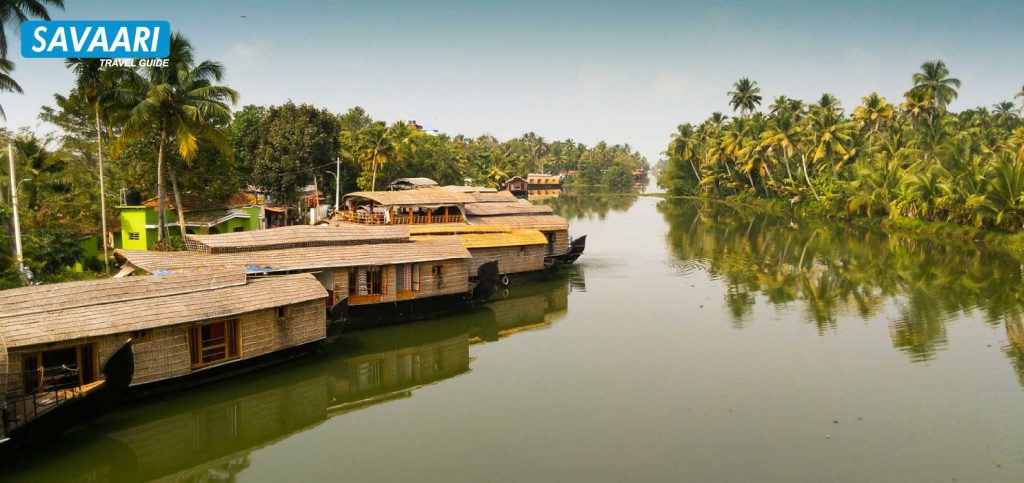As a diligent travel researcher, my work and wanderlust have taken me across the diverse landscapes of India. I’ve traced the paths of ancient empires, marvelling at the majestic remnants of temples and palaces that have withstood the test of time. My fascination with Buddhism, a philosophy entwined deeply in India’s spiritual fabric, was a significant driving force behind my journeys. My research took me to Bihar, the cradle of Buddhism, where the great sage Gautam Buddha embarked on his profound journey to understand and alleviate human suffering, eventually attaining enlightenment. Immersing myself in Bihar’s rich Buddhist heritage, I booked a Savaari and set out to trace the Bihar Buddhist circuit, a sacred trail commemorating the pivotal stages of Buddha’s life and teachings.
You may have pondered numerous questions about Buddhism in India. What caused Buddhism to spread far and wide from its birthplace in the humble settings of eastern India? How did Emperor Ashoka, once a ruthless conqueror, become a beacon of peace and an instrumental figure in the expansion of Buddhism? What lasting marks did the significant Buddhist councils, held in these very regions, leave on the trajectory of Buddhism? These are the questions we aim to answer, the secrets we hope to unearth, in a journey through the historical tapestry of Patna, Rajgir, Bodh Gaya, Sarnath, and Kesariya.
This journey traces the very roots of the region, breathing life into the profound legacy of Buddhism. It whispers narratives of a bygone era, its wisdom still deeply resonant today. You may wonder why, out of all the potential routes, this particular circuit through Patna and Bihar holds such significance. The connection is intimate and deep, dating back to the 6th century BC. It’s in the verdant landscapes of Bihar that Prince Siddhartha Gautama attained Enlightenment under the Bodhi tree. He then becomes the Buddha, the Enlightened One.
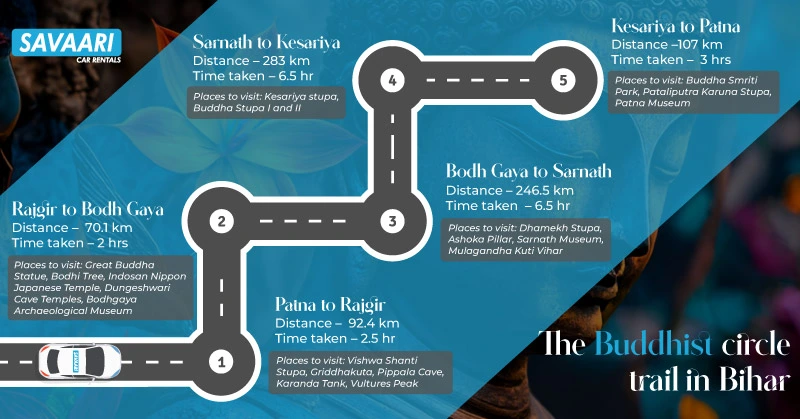
Each location whispers untold stories of Buddha’s life, teachings, and legacy. It transports us back to a time when Buddhism was nascent yet powerful. I’ve created a travel itinerary inspired by my knowledge and explorations of these locales. Whether you’re a seeker on the path of Buddhism or simply a history aficionado with a penchant for deep narratives, this Bihar Buddhist circuit itinerary promises an unforgettable journey.
Day 1: Start in Patna
I booked an hourly car rental and started my journey in Patna, the heart of Bihar, India, one of the world’s longest-standing inhabited regions. The chronicles of Patna unfold over three millennia, making every step I take a walk through history with my chauffeur Rajan Bhaiya. His remarkable expertise and profound understanding of the city’s heritage have granted me unparalleled insights. Rajan Bhaiya assured me, “In Patna, you shall find everything you seek.” This extraordinary city holds the answers to a multitude of questions.
This city has the unique honour of being intertwined with Buddhism and Jainism, the two most ancient religions globally. Pataliputra, the old name of the modern city of Patna, used to serve as the capital for the Mauryan, Shunga, and Gupta Empires. Its names reflect its rich past: it was Pataligama in Buddha’s time. It transformed into Pataliputra under King Asoka’s reign when it became the heart of his grand empire.
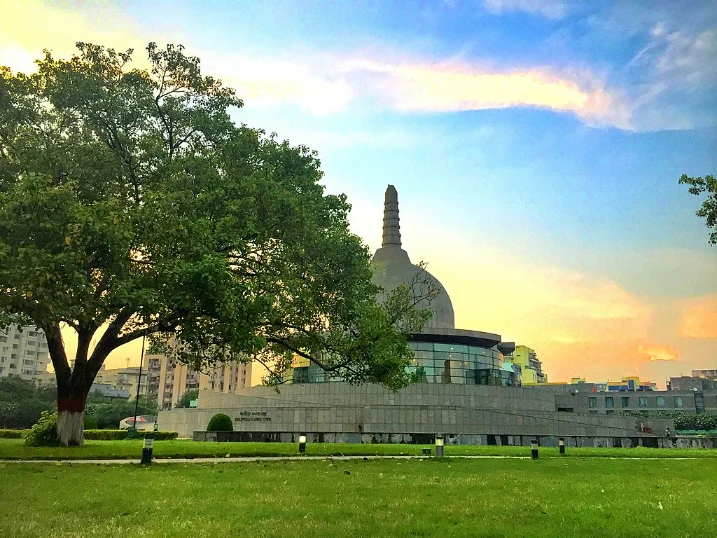
Why is Pataliputra (modern-day Patna) important to Buddhism?
Pataliputra, known today as Patna, is one of the significant places in the history of Buddhism. This is due to its connection to the Mauryan Empire, which played a key role in Buddhism’s growth. It was the capital of the Magadha Empire, which evolved into the Mauryan Empire. As the political and cultural centre of a vast empire, Pataliputra was a hub of intellectual activities. It attracted scholars from different fields, including many Buddhist scholars. Many of the edicts of the Mauryan Emperor Ashoka, a significant figure in Buddhism’s history, were proclaimed from there.
What role did Emperor Ashoka play in the spread of Buddhism from Patna?
Emperor Ashoka, after his conversion to Buddhism, played a pivotal role in spreading Buddhism both within his empire and beyond. He used the administrative machinery of his capital, Pataliputra, to foster this religious spread. Ashoka dispatched emissaries and missionaries to the Hellenistic kingdoms of the Mediterranean and other parts of Asia like Sri Lanka to propagate Buddhism. His efforts led to the first significant wave of Buddhism’s expansion. He transformed it from a regional Indian religion to an international one. Additionally, Ashoka codified and organized Buddhist teachings, contributed to Buddhist arts, and established many stupas and monasteries across his empire.
Are there any major Buddhist sites or remnants in Patna that date back to the Mauryan period?
Patna, rich in ancient history, does hold remnants of the Mauryan period, albeit not many directly linked to Buddhism. The Patna Museum holds many artefacts from the Mauryan era and subsequent periods, including sculptures and architectural pieces. The Didarganj Yakshi statue, a fine example of Mauryan art, is among the museum’s prized possessions. Although not a Buddhist relic per se, it represents the high level of craftsmanship during the Mauryan period. It is also reflected in Buddhist art and architecture from the same era.
Though it might appear as a dusty, seemingly ordinary city at first glance, Patna is a beacon for those on a Buddhist pilgrimage. Buddha himself had trod on this land multiple times, including during his last voyage to Kusinara. He imparted a discourse here that extended long into the night, further cementing the city’s spiritual significance. This intricate tapestry of history and spirituality is what makes Patna a unique stop in my journey.
Bihar Buddhist circuit places to visit in Patna:
- Buddha Smriti Park: No Bihar Buddhist circuit trail is complete without visiting the Buddha Smiriti Park. Built to celebrate Buddha’s 2554th birth anniversary, this city retreat spans 22 acres. Notable features include two Bodhi trees planted by the Dalai Lama and a Buddha statue.
- Pataliputra Karuna Stupa: The park boasts a library, a museum, a meditation centre, and a Memories Park. The focal point is the 200-ft-high stupa that houses an original relic of Buddha and many others from various countries, given by the Dalai Lama and monks. Its meditation centre, designed after Nalanda University monasteries, offers a view of the stupa from each cell. The museum presents Buddha’s life and teachings through multimedia.
- Patna Museum – Patna Museum houses several Buddhist artefacts. It has the pride and privilege of preserving the holy relic casket of Lord Buddha containing his ashes and other associated materials discovered during the excavation of a stupa belonging to 6th Century B.C. at Vaishali.
Day 2: Patna to Rajgir
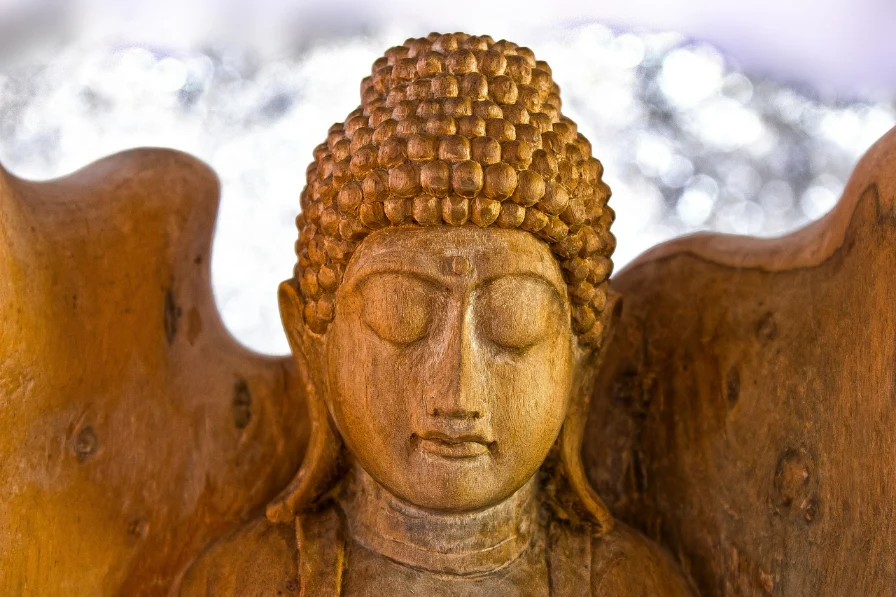
I booked a Savaari from Patna, as my next stop was Rajgir, a tranquil city tucked among the hills in Bihar’s Nalanda District. I was eager to visit the renowned Jivankamaravana Monastery, a place frequently graced by Buddha. Interestingly, Gridhakuta Hill, where Buddha shared many of his teachings, is also located here. I learnt from Rajan Bhaiya that the Jain Lord Mahavir spent part of his life in this city, adding another layer to its religious richness. Beyond its Buddhist and Jain roots, Rajgir is home to a multitude of Hindu temples. Locals shared intriguing stories about the unique ponds in the city, said to have waters with therapeutic properties beneficial for skin ailments.
What is the significance of the first Buddhist Council that took place in Rajgir?
The First Buddhist Council holds immense significance. It was the first collective attempt to preserve the teachings of the Buddha after his death, known as Mahaparinirvana. Convened by one of the Buddha’s foremost disciples, Mahakasyapa, the council was at the Sattapanni Cave in Rajgir. The main objectives of this council were to preserve the Buddha’s sayings (suttas) and monastic rules (Vinaya). Ananda, the Buddha’s attendant, was chosen to recite the suttas, while Upali recited the Vinaya. This event established the authoritative teachings of Buddhism. It formed the basis of the Tripitaka or the Pali Canon, the earliest and most complete collection of Buddhist scriptures.
How did the sermons delivered by the Buddha in Rajgir contribute to the teachings of Buddhism
The sermons delivered by the Buddha in Rajgir were significant because they added to the foundational teachings of Buddhism. Rajgir was a city where the Buddha spent many rainy seasons, and during his stay, he gave numerous teachings. The content of these sermons contributed to the broader understanding of the Dharma, the Buddhist teachings. These teachings include discourses on topics such as the nature of the self, the process of death and rebirth, the workings of karma, and the path to liberation. They helped to clarify and expand upon the core principles of Buddhism, aiding in the religion’s development and spread.
Specific Sutras or discourses delivered by the Buddha in Rajgir
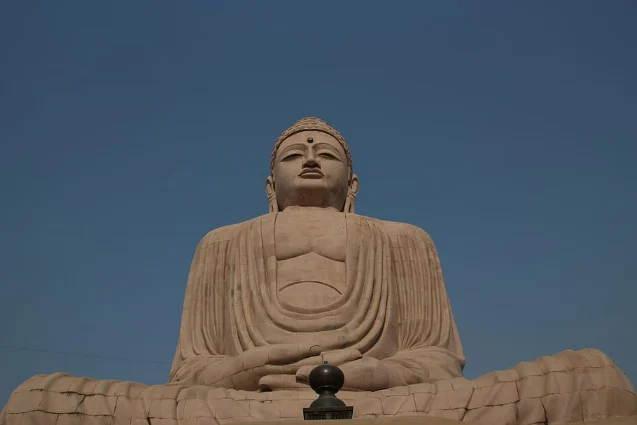
One of the most significant discourses delivered by the Buddha in Rajgir is the “Lotus Sutra” or “Saddharma Pundarika Sutra” in Sanskrit. It’s one of the most popular and influential Mahayana sutras and is famous for its extensive instruction on the concept and the path of the Bodhisattva.
The “Samaññaphala Sutta” (The Fruit of Contemplative Life Discourse) was also given in Rajgir. It’s the second discourse in the Digha Nikaya, a collection of the Buddha’s long discourses. This sutta outlines the benefits of living a contemplative life according to the Buddha’s teachings. Another notable discourse given in Rajgir is the “Kālāma Sutta” or the “Charter of Free Inquiry,” where the Buddha advises the Kālāmas, a clan living in Kesaputta, on how to prevent themselves from falling into religious doubt. I highly recommend taking a look at a travel guide that Rajan Bhaiya shared with me for maximizing my exploration of Nalanda. It’s a valuable resource to help you plan your trip and make the most out of your experience. After immersing myself in the deep cultural and spiritual heritage of Rajgir, I left with an enlightening journey filled with lessons from the past and hopes for the future.
Distance – 92.4 km
Time taken (approximately) – 2 hr 44 min
Bihar Buddhist circuit places visit in Rajgir
- Vishwa Shanti Stupa: Perched atop Ratnagiri Hill at an elevation of 400 meters, the Vishwa Shanti Stupa is one of Rajgir’s major attractions. This monument, built by the Japanese, draws visitors from across the globe.
- Griddhakuta: No Bihar Buddhist circuit trail is complete without visiting Griddhakuta. Also known as the “Hill of Vultures”, Griddhakuta was a favourite site of Gautam Buddha, where he delivered numerous sermons post-enlightenment. A ropeway leads to the top of Ratnagiri Hill, ferrying visitors to this spiritually significant site.
- Pippala Cave: This rock-cut cave, situated above hot springs on Vaibhava Hill near Rajgir, is believed to have been a sacred site during the time of Gautam Buddha.
- Karanda Tank: This historic bathing site is where Gautam Buddha is said to have bathed during his stays in Rajgir. The remnants of this tank bear witness to the splendid past of the Mauryan era and its architectural splendour.
- Vultures Peak: Known as the site where Buddhist monks practised meditation, Vultures Peak holds great significance in Buddhist history. Here, Buddha’s teachings were inscribed, and it also served as the venue for the first Buddhist Council. You can also spend the rest of the day exploring the ruins of the ancient Nalanda University and the Nalanda Museum.
[Also read: The legends and lore of India’s first temple]
Day 3: Rajgir to Bodh Gaya
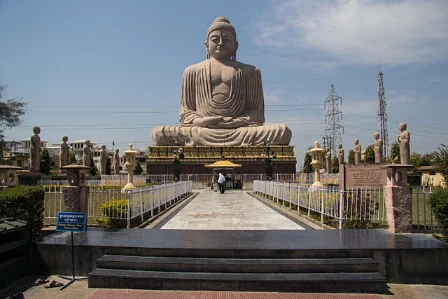
I left Rajgir in the early morning, setting my sights on Bodh Gaya. Located near the Neranjana River, Bodh Gaya was initially known as Uruwela. The city is one of the four key Buddhist sites alongside Kushinagar, Lumbini, and Sarnath. This location had been on my itinerary for a while, especially due to the historic Mahabodhi Temple. This is the very site where Gautama Buddha attained enlightenment under the Bodhi tree, making it a cornerstone of Buddhism. This UNESCO World Heritage Site has witnessed substantial international collaboration, with countries like Japan and China assisting the Indian government in enhancing facilities for Buddhist pilgrims. The site remains a hive of activity throughout the year, drawing crowds from across the globe who come to pay respects at the monasteries, temples, and remnants of the Bodhi Tree.
What makes the Bodhi tree in Bodh Gaya a key element in the history of Buddhism?
The Bodhi tree is deeply revered in Buddhism as it is believed to be the place where Prince Siddhartha attained enlightenment after meditating for 49 days and became Gautama Buddha. This transformative moment, symbolized by the Bodhi tree, is the cornerstone of Buddhist philosophy. Thus, the Bodhi tree in Bodh Gaya is not merely a tree but a living testament to the Buddha’s attainment of supreme wisdom and insight.
How did Bodh Gaya evolve into a prime destination for Buddhist pilgrimage?
Bodh Gaya, due to its direct connection to the Buddha’s enlightenment, naturally became a focal point for those seeking to understand and follow the Buddha’s teachings. It’s believed to be the “navel of the earth,” a place where one can connect with cosmic forces. Over centuries, kings, monks, and devotees contributed to building monasteries, temples, and educational institutions, further enhancing Bodh Gaya’s status as a Buddhist pilgrimage center.
Insights into the architectural symbolism of the Mahabodhi Temple at Bodh Gaya
The Mahabodhi Temple is a fine example of Buddhist architecture, blending elements of many eras and influences. The central tower, about 55 meters high, is surrounded by four smaller towers, all adorned with intricate carvings depicting scenes from the Buddha’s life and various Buddhist deities. The temple complex includes the Vajrasana (Diamond Throne), believed to be the spot where the Buddha sat and achieved enlightenment. The architecture itself symbolizes the Buddha’s journey, the stages of enlightenment, and elements of Buddhist cosmology.
With a heart full of gratitude and a mind enriched with wisdom, Rajan Bhaiya and I ended my exploration of the day, under the watchful shadows of the same Bodhi tree. Here’s a comprehensive travel guide on Bodh Gaya that helped me make the most out of my trip.
Distance – 70.1 km
Time taken (approximately) – 2 hr 11 min
Bihar Buddhist circuit places visit in Bodh Gaya
- Great Buddha Statue: This colossal 80-foot-tall statue of Buddha, constructed using a mix of sandstone and red granite, symbolizes Buddha in a state of deep meditation on a lotus, spreading an air of tranquillity. Completed over seven years with the help of 12,000 masons, the statue also houses a hollow spiral staircase and around 16,300 small bronze Buddha images.
- Bodhi Tree: Recognized as a direct descendent of the original Bodhi tree under which Buddha attained enlightenment, this large, sacred tree holds significant religious value. Its site also includes the Animisalocana cetiya, a shrine marking the spot of Buddha’s intense seven-week meditation.
- Indosan Nippon Japanese Temple: This temple, constructed in 1972, stands as a testament to Japanese architectural style. Carved from wood and displaying numerous Japanese paintings of Buddha’s life, its mission is to preserve and disseminate the teachings of Buddhism.
- Dungeshwari Cave Temples: Located approximately 14 km from Bodh Gaya, these caves are considered the place where Buddha spent six years before his enlightenment journey in Bodh Gaya. The tranquil ambience of the caves, along with their Hindu and Buddhist shrines, attract many travellers.
- Bodhgaya Archaeological Museum: Situated close to the Mahabodhi Temple complex, this museum holds an extensive collection of Hindu and Buddhist artefacts from the 2nd century BC to the 11th century CE. Its exceptional exhibits include intriguing images of Buddha, Manjusri, Maitreya, and other prominent figures from Buddhism.
- Muchalinda Lake: Named after the Serpent King Muchalinda, this sacred lake is said to be where Buddha spent the sixth week of his enlightenment process, protected by the king himself during a thunderstorm. Its pristine waters and verdant surroundings make it a peaceful sight to behold.
- Royal Bhutan Monastery: Royal Bhutan Monastery is a Buddhist monastery in Bodhgaya, commissioned by the King of Bhutan as a tribute to Lord Buddha. This monastery displays remarkable excerpts from Buddha’s life through 3D clay carvings. Its striking architecture, serene atmosphere, and seven-foot-tall Buddha statue make it a must-visit location.
[Also read: Gaya to Patna Road Trip – Distance, Time and Useful Travel Information]
Day 4: Bodh Gaya to Sarnath
Sarnath is one of the major attractions for Buddhist pilgrims. This is where Lord Buddha, after attaining nirvana, sought out his five companions who had left him in Rajgir due to differing views on self-mortification. To my fascination, it was here in Deer Park that Buddha delivered his inaugural sermon. I was also astounded to learn about King Ashoka, who promoted Buddha’s teachings of love and compassion throughout his expansive empire and constructed a stupa here around 234 BC.
How did Buddha’s first sermon at Sarnath shape the understanding of Buddhism?
The Buddha’s first sermon at Sarnath, known as the “Dhammacakkappavattana Sutta” or the “Setting the Wheel of Dhamma in Motion,” is critical because it marks the point where he first taught the Four Noble Truths and the Eightfold Path. These are the foundational teachings of Buddhism, and this event signifies the beginning of the Buddha’s public ministry and the start of the Sangha, the community of monks.
The historical significance of the Dhamek Stupa and the Ashoka Pillar at Sarnath
The Dhamek Stupa is believed to mark the exact spot of the Buddha’s first sermon, making it a profoundly significant monument. The Ashoka Pillar, erected by Emperor Ashoka, bears the four lion heads, which were adopted as India’s national emblem. The pillar’s edicts embody the principles of the Dhamma, attesting to Emperor Ashoka’s commitment to the spread of Buddhism.
In what ways did Sarnath contribute to the evolution of Buddhist art and architecture?
Sarnath became a significant centre of Buddhist arts during the Gupta period (4th to 6th century CE). It was known as the “Golden Age of India.” The period saw the development of the “Sarnath School of Art,” characterized by beautiful sculptures made of sandstone. These works of art depict the Buddha, Bodhisattvas, and scenes from Buddhist legends, contributing significantly to the iconography of Buddhism.
Seeing the numerous Buddhist structures erected between the 3rd century BC and the 11th century AD, I was amazed by the expansive ruins that Sarnath boasts among all the places on the Bihar Buddhist Circuit. The best way to explore Sarnath to the fullest is by booking an hourly cab.
Distance – 246.5 km
Time taken (approximately) – 6 hr 23 min
Buddhist circuit places visit in Sarnath
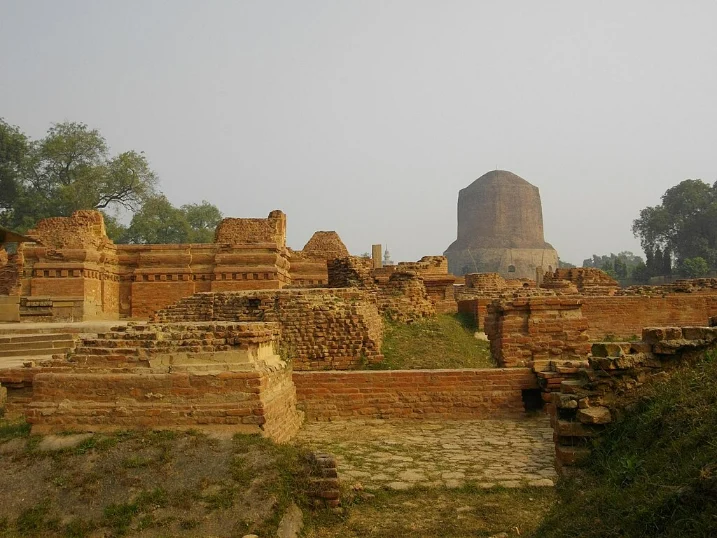
- Dhamekh Stupa: Dhamekh Stupa is an imposing structure with a height of 43.6 meters and a diameter of 28 meters, was built by Emperor Ashoka in 249 BCE. It is the site where Buddha delivered his first sermon, setting the ‘Wheel of Dharma’ into motion. To this day, Buddhists continue to worship by circumambulating the cylindrical red stone stupa.
- Ashoka Pillar: The Ashoka Pillar, also known as the Sarnath Pillar, features a distinct design of four standing lions and a chakra, which is now our national emblem. This towering structure has symbolic animal representations denoting various phases of Buddha’s life. Despite most of the surrounding structures being in ruins, it remains a significant attraction for tourists.
- Sarnath Museum: No Bihar Buddhist circuit trail is complete without visiting the Sarnath Museum. Established in 1910, the museum showcases a remarkable array of relics from various archaeological excavations in Sarnath. This includes artefacts, coins, and sculptures from the Maurya Dynasty.
- Mulagandha Kuti Vihar: Mulagandha Kuti Vihar is an enchanting temple, once used as a monastery. It draws visitors in with its large entrance bell and prayer wheels. The breathtaking frescoes adorning its walls and ceilings offer a serene and captivating experience for all who visit.
Day 6: Sarnath to Kesariya
From the highway, the imposing Kesariya Stupa, emerging from the surrounding marshlands, was quite a sight. It stood in stark contrast to the refined majesty of Bodh Gaya, My mind spontaneously conjured up comparisons with Borobudur, the revered Buddhist temple in Indonesia.
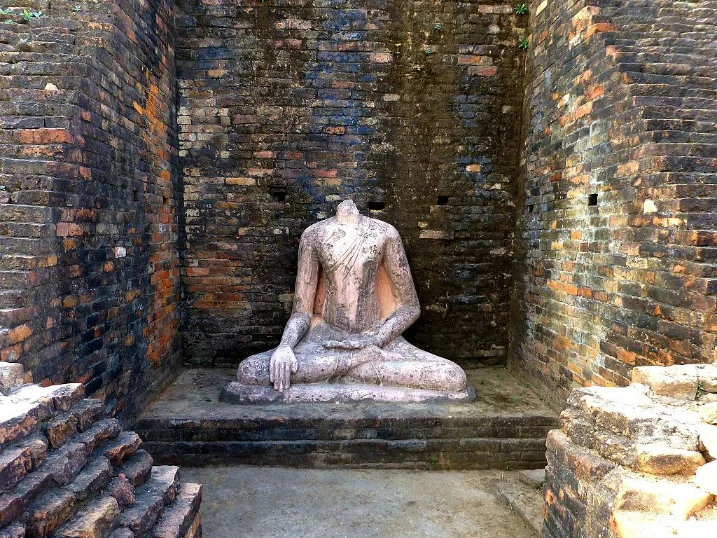
There’s even speculation amongst historians that this might be India’s Borobudur counterpart. The Kesaria Stupa, located in the state of Bihar, is the tallest and largest Buddhist stupa in the world. This stupa holds a significant place in history. It is where Buddha handed over his alms bowl to his monks from Vaishali, indicating that he was preparing to depart. This location was where he delivered his final sermon and made known his forthcoming nirvana. Subsequently, Buddha set off for Kushinagar.
The stupa at Kesariya seemed to be off the beaten track, attracting mostly local youngsters and students, rather than hordes of tourists. However, my spirits lifted when a large group of Vietnamese pilgrims, including monks and devotees, arrived to show their respects, adding a unique touch of devotion and serenity to the place.
What makes the Kesariya Stupa an important site in Buddhism?
The Kesariya Stupa, being the tallest Buddhist stupa in the world, holds archaeological and historical significance. It is the site where the Buddha gave his alms bowl to the Licchavis. It marks a crucial event during the end of the Buddha’s earthly life.
An insight into the incident of the Buddha giving his alms bowl to the Licchavis at Kesariya
During his last journey, the Buddha stopped at Kesariya and, sensing his impending passing, he gave his alms bowl to the Licchavis, a local ruling clan. He then instructed them to return to Vaishali. This act symbolizes the Buddha letting go of material possessions and preparing for his final departure, known as Mahaparinirvana.
How does the design of the Kesariya Stupa reflect Buddhist teachings and philosophy?
The architectural design of the Kesariya Stupa, with its concentric terraced circles, symbolizes the stages of enlightenment. Each level could represent a step on the path towards achieving Nirvana. It embodies the essence of Buddhist philosophy – the journey towards liberation from the cycle of birth and death.
Distance – 283 km
Time taken (approximately) – 6 hr 33 min
Day 7: Kesariya to Patna
After several days of soaking in spiritual serenity, I felt enlightened, fulfilled, and at peace. With a rejuvenated spirit, I headed back to Patna and spent the day leisurely exploring the local ambience. I wandered through the bustling markets, where I discovered a Tibetan enclave brimming with colourful handicrafts and exotic curios. I also got the chance to indulge in local culinary delights such as Litti Chokha, a traditional Bihari dish, and Batata Puri, a delightful snack.
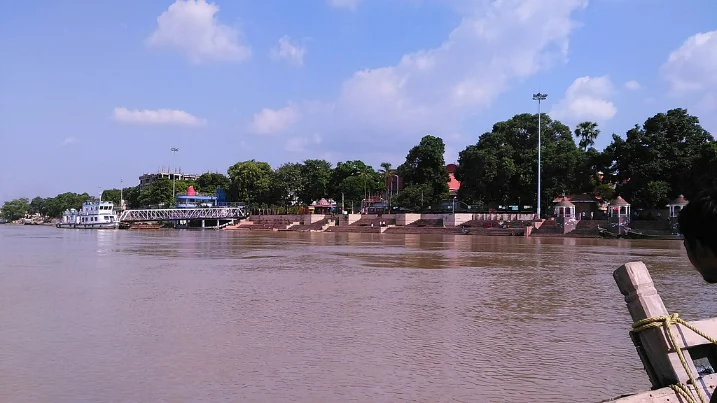
As the day waned, I found myself drawn to the banks of the Ganga River. It is often considered the soul of Patna. The peaceful flow of water and the verdant vistas lining one shore created a mesmerizing contrast. To savour this experience, I joined some newly-made friends for a boat ride on the tranquil waters of the Ganga. It is an ideal escape from the hustle and bustle of the city. As we gently bobbed on the pristine waters, we embraced serenity and solitude. It was surreal, far removed from the city’s bustling streets.
Distance –107 km
Time taken (approximately) – 3 hr 12 min
Why go on a Bihar Buddhist circuit trail?
Travelling the Bihar Buddhist circuit trail is an endeavour that I recommend to all. The lessons gleaned from Buddhism’s philosophical depths, its rich history, and its enduring influence on societies are not just enlightening but universally relevant.
Moreover, my journey exploring Buddhist places in Bihar was an incredibly educational, and trouble-free experience. All it took was a simple download of the Savaari car rental app, and my expedition was smoothly arranged. Having a seasoned driver like Rajan Bhaiya, who possesses a deep understanding of the local culture was an invaluable asset. The trip is not solely about seeing the ancient monasteries, stupas, and relics. It’s about deciphering the story woven into them, the culture they’ve molded, and the enduring wisdom they still emit.
Ultimately, the Bihar Buddhist circuit trail is a path that transcends mere tourism. It’s a voyage that subtly shapes our understanding of life and our place within it, echoing the universal Buddhist values of compassion, mindfulness, and inner peace. So, step onto this trail, and let it lead you not just through beautiful landscapes and historic monuments, but also towards a heightened sense of understanding and inner peace.
Useful travel links
- Centre plans major infrastructure push for Buddhist Circuit
- Indian Railways To Launch Buddhist Circuit Tourist Train From Safdarjung
Last Updated on January 17, 2024 by



